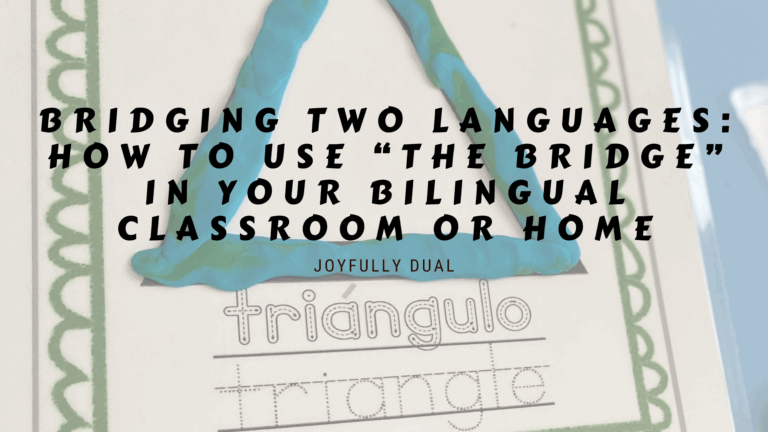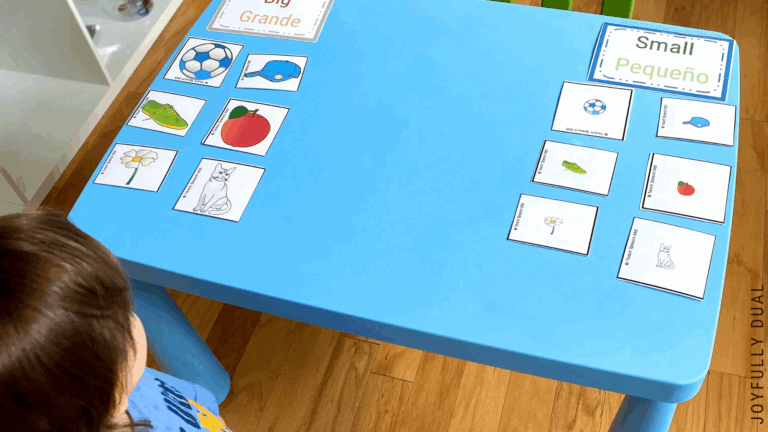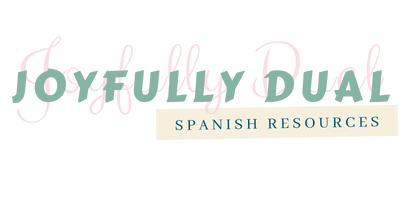
If you’re raising or teaching bilingual kids, you’ve probably asked yourself: How can I help my children/students connect both of their languages in meaningful ways? One powerful answer in bilingual education is The Bridge.
Whether you’re a Spanish dual language teacher or a bilingual homeschooling parent, incorporating The Bridge into your routine builds stronger vocabulary, deeper understanding, and powerful metalinguistic awareness.
As a former dual language teacher and now a bilingual homeschool mama, I’ve seen firsthand how bridging strengthens both Spanish and English in my kids. It’s not just a cute idea; it’s a research-based practice that helps children become truly biliterate.
What Is “The Bridge” in Bilingual Education?
The Bridge, in bilingual and dual language programs, is a specific instructional moment when students are guided to make intentional connections between two languages, such as Spanish and English in this case.
It’s not about translation, it’s about building metalinguistic awareness.
During The Bridge, children compare and contrast vocabulary, spelling, grammar, and language structures. They’re encouraged to think about how the two languages work, where they overlap, and how they’re different. This process helps children transfer what they’ve learned in one language to the other.
Why The Bridge Is Powerful for Bilingual Learners
When we use The Bridge in bilingual education consistently:
- Students transfer academic vocabulary and content across languages
- They develop a deeper understanding of how language works
- It promotes confidence in both Spanish and English
- Kids become better problem-solvers and thinkers
- It supports long-term retention through meaningful language connections
In our home, I’ve used The Bridge to help my kindergarten compare and connect letter sounds in Spanish and English. His eyes light up when he makes those connections, and he begins to feel proud of his bilingualism.
How to Use The Bridge in Class or at Home
Here are some strategies to incorporate The Bridge:
1. Teach First, Bridge Later
Teach a concept in one language first (usually the language of instruction), then bridge key vocabulary, grammar points, or concepts. Talk about similarities and differences in how the languages express the same ideas.
Example: Teach the life cycle of a butterfly in Spanish, then bridge:
- oruga = caterpillar
- crisálida = chrysalis
- metamorfosis = metamorphosis (cognate!)
2. Use Anchor Charts or Visual Tools
Create side-by-side comparison charts of key vocabulary or concepts:
- Label one column “Español” and the other “English”
- Include images to support understanding
- Use color coding to show gender, articles, etc.
Great topics for bridging visuals:
- Noun-adjective agreement
- Articles (el/la vs. the)
- Subject-verb order
- Common cognates
Visuals help make patterns and differences more obvious.
3. Play Cognate Matching Games
Cognates are your best friends in The Bridge! Use matching cards or sorts to pair words that sound/look alike in both languages.
Ideas:
- Card games
- Word wall of weekly cognates
- True vs. false cognate sorts
Use it as a conversation starter: “Why do you think these words look the same in both languages?”
4. Reflect in Writing
After reading or writing in one language, bridge key vocabulary or sentence structures. You can also have them revise a short Spanish writing by bridging it to English, just key parts, not word-for-word.
Prompt Examples:
- “What words were easy to transfer to English?”
- “Which words don’t translate easily? Why?”
- “What’s a grammar rule that works differently?”
5. Use Sentence Frames to Compare
Scaffold language comparisons:
- “In Spanish, we say ____, but in English we say ____.”
- “Both words mean the same, but they sound different.”
- “This rule works in both languages.”
These sentence frames help students internalize structure and vocabulary in both languages.

Remember, Bridging isn’t about repeating or translating; it’s about empowering children to think in two languages, notice patterns, and transfer knowledge intentionally.
Whether you’re in a classroom or on your living room floor, using The Bridge helps children become confident, curious, and meta-linguistically aware bilinguals.
Let’s raise joyful bilingual thinkers one bridge at a time.
Have you used The Bridge in your teaching or homeschooling? What’s worked for you? Leave a comment below! I would love to hear your ideas.
Teaching littles? Check out my post Bridging Two Languages: Easy Ideas for Early Learners for PreK–2nd grade tips!
